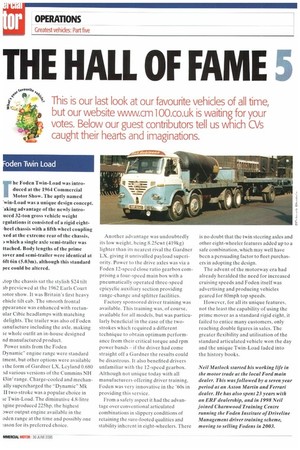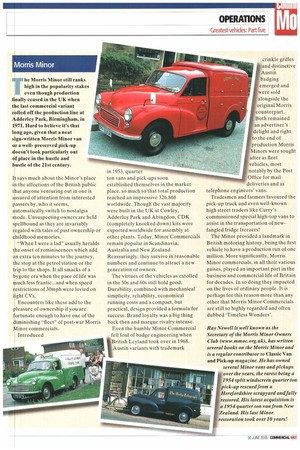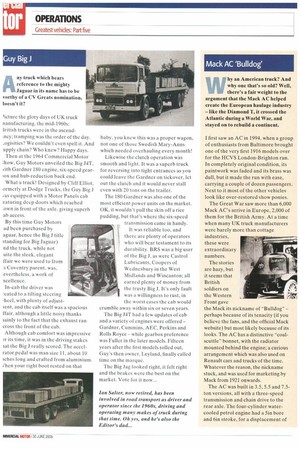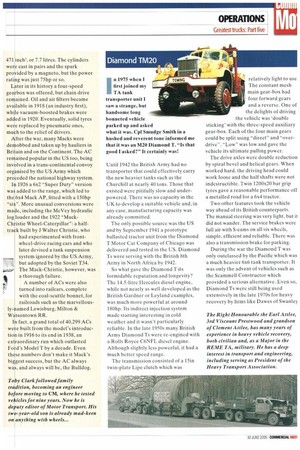THE HALL OF FAME 5
Page 52

Page 53

Page 54

Page 55

If you've noticed an error in this article please click here to report it so we can fix it.
■ M
L % This is our last look at our favourite vehicles of all time,
but our vvebsite vwvw.cm100.co.uk is waiting for your votes. Below our guest contributors tell us which CVs caught their hearts and imaginations.
oden Twin Load
Ihe Foden Twin-Load was introduced at the 1964 Commercial Motor Show. The aptly named 'win-Load was a unique design concept. 'aking advantage of the newly introaced 32-ton gross vehicle weight egulations it consisted of a rigid eightheel chassis with a fifth wheel coupling xed at the extreme rear of the chassis, ) which a single axle semi-trailer was ttached. Body lengths of the prime Lover and semi-trailer were identical at 6ft 6in (5.03m), although this standard pee could be altered.
,top the chassis sat the stylish S24 tilt rib previewed at the 1962 Earls Court totor show. It was Britain's first heavy ehicle tilt cab. The smooth frontal ppearance was enhanced with rectanular Cibie headlamps with matching delights. The trailer was also of Foden ianufacture including the axle, making le whole outfit an in-house designed ad manufactured product.
Power units from the Foden Dynamic" engine range were standard tment, but other options were available the form of Gardner LX, Leyland 0.680 ad various versions of the Cummins NH 13in3 range. Charge-cooled and mechanally supercharged the "Dynamic" Mk II two-stroke was a popular choice in Le Twin-Load. The diminutive 4.8-litre tgine produced 225hp, the highest 3wer output engine available in the oden range at the time and possibly one ;ason for its preferred choice. Another advantage was undoubtedly its low weight, being 8.25cwt (419kg) lighter than its nearest rival the Gardner LX. giving it unrivalled payload superiority. Power to the drive axles was via a Foden 12-speed close ratio gearbox comprising a four-speed main box with a pneumatically operated three-speed epicyclic auxiliary section providing range-change and splitter facilities.
Factory sponsored driver training was available. This training was, of course, available for all models, but was particularly beneficial in the case of the twostrokes which required a different technique to obtain optimum performance from their critical torque and rpm power bands — if the driver had come straight off a Gardner the results could be disastrous. It also benefited drivers unfamiliar with the 12-speed gearbox. Although not unique today with all manufacturers offering driver training. Foden was very innovative in the '60s in providing this service.
From a safety aspect it had the advantage over conventional articulated combinations in slippery conditions of retaining the sure-footed qualities and stability inherent in eight-wheelers. There is no doubt that the twin steering axles and other eight-wheeler features added up to a safe combination, which may well have been a persuading factor to fleet purchasers in adopting the design.
The advent of the motorway era had already heralded the need for increased cruising speeds and Foden itself was advertising and producing vehicles geared for 80mph top speeds.
However, for all its unique features, not the least the capability of using the prime mover as a standard rigid eight, it failed to entice many customers, only reaching double figures in sales. The greater flexibility and utilisation of the standard articulated vehicle won the day and the unique Twin-Load faded into the history books.
Neil Matlock started his working life in the motor trade at the local Ford main dealer. This was followed by a seven year period at an Aston Martin and Ferrari dealer. He has also spent 23 years with an ERF dealership, and in 1998 Neil joined Charts wood Training Centre running the Foden Institute of Driveline Management driver training scheme, moving to selling Fodens in 2003.
Morris Minor
he Morris Minor still ranks high in the popularity stakes even though production nally ceased in the UK when e last commercial variant lied off the production line at dderley Park, Birmingham, in 71. Hard to believe it's that rig ago, given that a neat gn-written Morris Minor van r a wellpreserved pick-up oesn't look particularly out f place in the hustle and ustle of the 21st century.
I says much about the Minor's place i the affections of the British public t at anyone venturing out in one is ssured of attention from interested assers by, who it seems, utomatically switch to nostalgia ode. Unsuspecting owners are held ellbound as they are invariably galed with tales of past ownership or hildhood memories.
"When 1. were a lad" usually heralds t e onset of reminiscences which add n extra ten minutes to the journey, U e stop at the petrol station or the p to the shops. It all smacks of a ygone era when the pace of life was uch less frantic.. .and when speed estrictions of 30mph were levied on I ght CVs.
Encounters like these add to the leasure of ownership if you are ortunate enough to have one of the iminishing "fleet" of post-war Morris mor commercials.
Introduced in 1953, quarter ton vans and pick-ups soon established themselves in the market place, so much so that total production reached an impressive 326,868 worldwide. Though the vast majority were built in the UK at Cowley, Adderley Park and Abingdon, CDK (completely knocked down) kits were exported worldwide for assembly at other plants. Today, Minor Commercials remain popular in Scandinavia, Australia and New Zealand. Reassuringly, they survive in reasonable numbers and continue to attract a new generation of owners.
The virtues of the vehicles as extolled in the 50s and 60s still hold good. Durability, combined with mechanical simplicity, reliability, economical running costs and a compact, but practical, design provided a formula for success. Brand loyalty was a big thing back then and marque rivalry intense.
Even the humble Minor Commercial fell foul of badge engineering when iBritish Leyland took over in 1968. Austin variants with trademark crinkle grilles and distinctive Austin badging emerged and were sold alongside the original Morris counterpart.
Both remained an advertiser's delight and right o the end of production Morris Minors were sought after as fleet vehicles, most notably by the Post Office for mail deliveries and as telephone engineers' vans.
Tradesmen and farmers favoured the pick-up truck and even well-known high street traders like Curry's commissioned special high-top vans to assist in the transportation of newfangled fridge freezers!
The Minor provided a landmark in British motoring history, being the first vehicle to have a production run of one million. More significantly, Morris Minor commercials, in all their various guises, played an important part in the business and commercial life of Britain for decades. In so doing they impacted on the lives of ordinary people. It is perhaps for this reason more than any other that Morris Minor Commercials are still so highly regarded and often dubbed 'Timeless Wonders'.
Ray Newell is well known as the Secretary of the Morris Minor Owners Club (www.mmoc.org.uk), has written several books on the Morris Minor and is a regular contributor to Classic Van and Pick-up magazine. He has owned several Minor vans and pickups over the years, the rarest being a 1954 split windscreen quarter ton pick-up rescued from a Herefordshire scrapyard and fully restored. His latest acquisition is a 1954 quarter ton van from New Zealand His last Minor restoration took over 10 years!
Guy Big
Any truck which bears reference to the mighty Jaguar in its name has to be vorthy of a CV Greats nomination. loesn't it?
)icture the glory days of UK truck nanufacturing. the mid-1960s: iritish trucks were in the ascend[ncy; tramping was the order of the day. ..ogisities? We couldn't even spell it. And upply chain? Who knew? Happy days. Then at the 1964 Commercial Motor ;how, Guy Motors unveiled the Big J4T, vith Gardner 180 engine, six-speed gearlox and hub-reduction back end. What a truck! Designed by Cliff Elliot. ormerly at Dodge Trucks, the Guy Big J as equipped with a Motor Panels cab eaturing deep doors which reached [own in front of the axle, giving superb ab access.
By this time Guy Motors .ad been purchased by aguar, hence the Big J title standing for Big Jaguar) nd the truck, while not uite the sleek, elegant flair we were used to from .5 Coventry parent, was, evertheless. a work of xcellence.
In-cab the driver was :eated to a tilting steering 'heel, with plenty of adjustlent, and the cab itself was a spacious flair, although a little noisy thanks iainly to the fact that the exhaust ran cross the front of the cab.
Although cab comfort was impressive mits time, it was in the driving stakes at the Big J really scored. The accelrator pedal was man size 11, about 10 aches long and crafted from aluminium. /hen your right boot rested on that baby, you knew this was a proper wagon, not one of those Swedish Mary-Anns which needed overhauling every month!
Likewise the clutch operation was smooth and light. It was a superb truck for reversing into tight entrances as you could leave the Gardner on tickover, let out the clutch and it would never stall even with 20 tons on the trailer.
The 180 Gardner was also one of the most efficient power units on the market. OK, it wouldn't pull the skin off a rice pudding, but that's where the six-speed transmission came in handy.
It was reliable too, and there are plenty of operators who will bear testament to its durability. BRS was a big user of the Big .1, as were Castrol Lubricants, Coopers of Wednesbury in the West Midlands and Wincanton; all earned plenty of money from the trusty Big J. It's only fault was a willingness to rust, in the worst cases the cab would crumble away within six or seven years.
The Big .14T had a few updates of cab and a variety of engines were offered Gardner, Cummins, AEC, Perkins and Rolls Royce while gearbox preference was Fuller in the later models. Fifteen years after the first models rolled out, Guy's then owner, Leyland, finally called time on the marque, The Big Jag looked right, it felt right and the brakes were the best on the market. Vote for it now...
Ian Salter, now retired, has been involved in road transport as driver and operator since the 1960s, driving and operating many makes of truck during that time. Oh yes, and he's also the Editor's dad...
Mack AC 'Bulldog'
W— hy an American truck? And why one that's so old? Well, there's a fair weight to the argument that the Mack AC helped create the European haulage industry like the Diamond T, it crossed the Atlantic during a World War, and stayed on to rebuild a continent.
I first saw an AC in 1994, when a group of enthusiasts from Baltimore brought one of the very first 1916 models over for the HCVS London-Brighton run. In completely original condition, its paintwork was faded and its brass was dull, but it made the run with ease, carrying a couple of dozen passengers. Next to it most of the other vehicles look like over-restored show ponies.
The Great War saw more than 6,000 Mack AC's arrive in Europe, 2,000 of them for the British Army. At a time when many UK truck manufacturers were barely more than cottage industries, these were extraordinary numbers.
The stories are hazy, but it seems that British soldiers on the Western Front gave the Mack its nickname of "Bulldog" perhaps because of its tenacity (if you believe the fans, and the official Mack website) but most likely because of its looks. The AC has a distinctive "coalscuttle" bonnet, with the radiator mounted behind the engine; a curious arrangement which was also used on Renault cars and trucks of the time. Whatever the reason, the nickname stuck, and was used for marketing by Mack from 1921 onwards.
The AC was built in 3.5, 5.5 and 7.5ton versions, all with a three-speed transmission and chain drive to the rear axle. The four-cylinder watercooled petrol engine had a Sin bore and fin stroke, for a displacement of 471 inch3. or 7.7 litres. The cylinders were cast in pairs and the spark provided by a magneto, but the power rating was just 75hp or so.
Later in its history a four-speed gea box was offered, but chain drive re ained. Oil and air filters became ava lable in 1918 (an industry first), whe vacuum-boosted brakes were ad ed in 1920. Eventually, solid tyres we e replaced by pneumatic ones, mu h to the relief of drivers.
her the war, many Macks were de obbed and taken up by hauliers in Bri am n and on the Continent. The AC re ained popular in the US too, being inv lved in a trans-continental convoy org nised by the US Army which pre eded the national highway system.
I 1926 a 6x2 "Super Duty" version wa added to the range, which led to the 6x4 Mack AP, fitted with a 150hp "Si ". More unusual conversions were ma e, including the McVey hydraulic log loader and the 1922 "MackCh istie Wheel-Caterpillar": a halftra k built by J Walter Christie, who had experimented with frontwheel-drive racing cars and who later devised a tank suspension system ignored by the US Army, but adopted by the Soviet T34. The Mack-Christie, however, was a thorough failure.
A number of ACs were also turned into railcars, complete with the coal-scuttle bonnet, for railroads such as the marvellouslyamed Lewisburg, Milton & W tsontown RR.
I fact, a grand total of 40,299 ACs we e built from the model's introductio in 1916 to its end in 1938, an ex raordinary run which outlasted Fo d's Model T by a decade. Even th se numbers don't make it Mack's bi gest success, but the AC always wa , and always will be, the Bulldog.
To y Clark followed family tr dition, becoming an engineer be ore moving to CM, where he tested ye icles for nine years. Now he is de uty editor of Motor Transport. His tw -year-old son is already mad-keen on anything with wheels... n 1975 when I first joined my TA tank transporter unit I saw a strange, but handsome long bonneted vehicle parked up and asked what it was. Cpl Smudge Smith in a hushed and reverent tone informed me that it was an M20 Diamond T. "Is that good I asked?" It certainly was!
Until 1942 the British Army had no transporter that could effectively carry the new heavier tanks such as the Churchill at nearly 40 tons. Those that existed were pitifully slow and underpowered. There was no capacity in the UK to develop a suitable vehicle and, in any case, manufacturing capacity was already committed.
The only possible source was the US and by September 1941 a prototype ballasted tractor unit from the Diamond T Motor Car Company of Chicago was delivered and tested in the US. Diamond Ts were serving with the British 8th Army in North Africa by 1942.
So what gave the Diamond T its formidable reputation and longevity? The 14.5-litre Hercules diesel engine, while not nearly as well developed as the British Gardner or Leyland examples, was much more powerful at around 180hp. Its indirect injection system made starting interesting in cold weather and it wasn't particularly reliable. In the late 1950s many British Army Diamond Ts were re-engined with a Rolls Royce C6NFL diesel engine. Although slightly less powerful, it had a much better speed range.
The transmission consisted of a 15in twin-plate Lipe clutch which was relatively light to use The constant mesh main gear-box had four forward gears and a reverse. One of the delights of driving the vehicle was 'double sticking' with the three-speed auxiliary gear-box. Each of the four main gears could be split using "direct" and "overdrive". "Low" was low and gave the vehicle its ultimate pulling power.
The drive axles were double reduction by spiral bevel and helical gears. When worked hard, the driving head could work loose and the half shafts were not indestructible. Twin 1200x20 bar grip tyres gave a reasonable performance off a metalled road for a 6x4 tractor.
Two other features took the vehicle way ahead of its British counterparts. The manual steering was very light, but ii did not wander. The service brakes were full air with S-cams on all six wheels, simple. efficient and reliable. There was also a transmission brake for parking.
During the war the Diamond T was only outclassed by the Pacific which was a much heavier 6x6 tank transporter. It was only the advent of vehicles such as the Scammell Constructor which provided a serious alternative. Even so, Diamond Ts were still being used extensively in the late 1970s for heavy recovery by firms like Dawes of Swanle) The Right Honourable the Earl Attlee, 3rd Viscount Prestwood and grandson of Clement Attlee, has many years of experience in heavy vehicle recovery, both civilian and, as a Major in the REME TA, military. He has a deep interest in transport and engineering, Including serving as President of the Heavy Transport Association.


































































































































































































